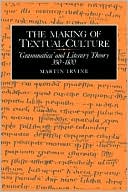

 |

|

The average rating for Making of Textual Culture: Grammatica and Literary Theory 350-1100 based on 2 reviews is 4.5 stars.
Review # 1 was written on 2020-06-15 00:00:00 Paul Moreno Paul MorenoI read the excerpted text available thru Google books and am trying to see whether Irvine's description of the 'prescriptive' contents of grammatical MSS is applicable to the homiletic-exegetical collection in the MS I am editing. |
Review # 2 was written on 2010-05-08 00:00:00 Arthur Anderson Arthur AndersonThis introduction to Latin literature will be especially useful to undergraduates coming to the Latin classics (whether in the original or translation) for the first time. The book's chief merit is the manner in which it sets various works of Latin literature in their cultural context, revealing how products of Latin literature, while often being modeled on Greek literary antecedents, are uniquely reflective of the values and ideals of the Romans. The author also deals with the manner in which certain famous Latin stories are handled in later traditions (e.g., her discussion of Renaissance paintings depicting the rape of Lucretia, a story in Book I of Livy's history). A whole book could be written on the influence of Ovid's Metamorphoses on later (Renaissance) painters. Also addressed in various places are important critical issues that have occupied scholars of Latin literature in more recent times. This little volume contains the following chapters: 1. Virgil and the Meaning of the Aeneid 2. Role models for Roman women and men in Livy 3. What is Latin literature? 4. What does studying Latin literature involve? 5. Making Roman identity: multiculturalism, militarism and masculinity 6. Performance and spectacle, life and death 7. Intersections of power: praise, politics and patrons 8. Annihilation and abjection: living death and living slavery 9. Writing 'real' lives 10. Introspection and individual identity 11. Literary texture and intertextuality 12.Metapoetics 13. Allegory 14. Overcoming an inferiority complex: the relationship with Greek literature 15. Building Rome and Building Roman literature Appendix A Extract From Darkness Visible by W.R. Johnson Appendix B Who's afraid of literary theory? by Simon Goldhill List of Authors and Texts Time-line List of translations used / adapted Index of Names and Topics Index of Passages quoted. In her chapter on the Aeneid, the author provides an excellent summary of the critical battle that scholars have waged for decades concerning Aeneas' killing of Turnus in Aeneid 12. Is this controversial climactic scene "pro-Augustan" or "anti-Augustan"? Braund musters the arguments for both sides, along with passages from other books of the poem, political considerations, and viewpoints from Roman philosophical school that are relevant to the discussion. Each chapter concludes with a short section entitled "Further Reading and Study" in which she discusses recent scholarly articles and books that have opened new critical avenues. |
CAN'T FIND WHAT YOU'RE LOOKING FOR? CLICK HERE!!!